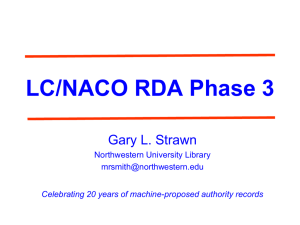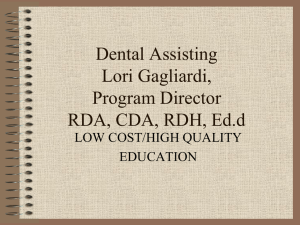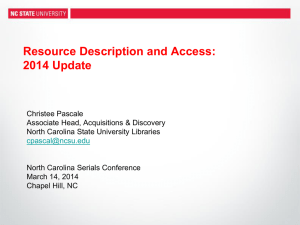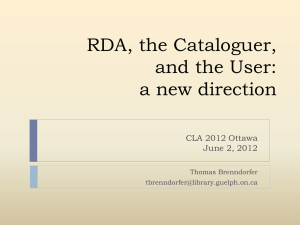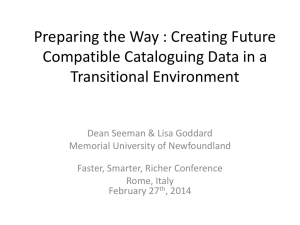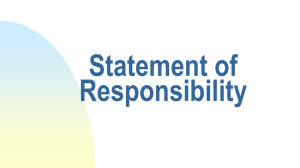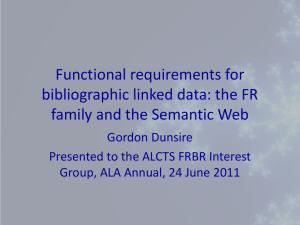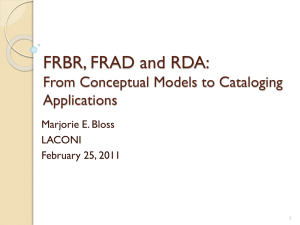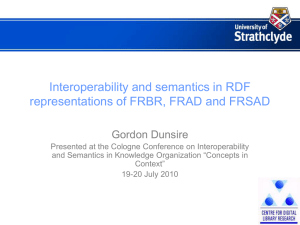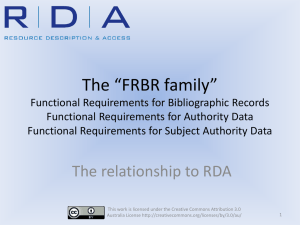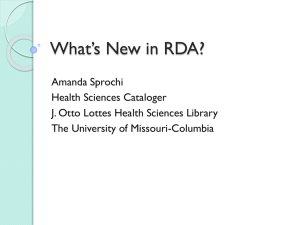RDA for OLIS cataloguers Transfer training
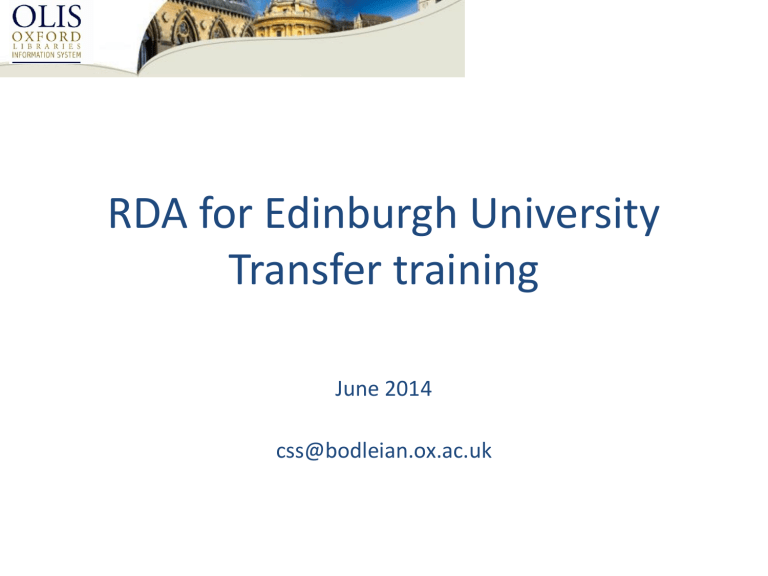
RDA for Edinburgh University
Transfer training
June 2014 css@bodleian.ox.ac.uk
Why RDA?
• RECORD SHARING
• Uses FRBR principles for cost-effective customer service
• Format-neutral and flexible o more uses for our data o more data for us to use
• Facilitates more intuitive post-MARC systems
• Avoids bookism
• Avoids Anglo-Americanism
• Avoids libraryism
FRBR: user tasks
•
Find records or materials
•
Identify resources unambiguously
•
Select the most suitable
•
Obtain what is wanted
• Work
FRBR: Group 1 entities & their attributes
o Voina i mir – written by Tolstoy – 1865-1867.
• realised in Expression o in English – text – translated by Constance Garnett – illustrated by John Groth – 1911.
• embodied in Manifestation o War and peace : a novel – Heinemann – London – 1961.
• exemplified in Item o Printed 1983 – Bodleian copy 2 – at Swindon – lacks p.
313 – MS notes by Stephen Fry.
New work or new expression?
Relationships in the Organization of Knowledge, edited by Carol A. Bean and Rebecca Green, 2001, p. 23, “Bibliographic Relationships” by
Barbara B. Tillett, Figure 2, © 2001 Kluwer Academic Publishers Boston.
FRBR: Group 2 entities & their attributes (mainly for NACO)
• Person o Tolstoy, Leo – Graf – 1828-1910 – Russian – male – writer of Anna Karenina etc.
• Corporate body o Heinemann – founded by William Heinemann – 1890 – now owned by Pearson, Random House and Houghton
Mifflin – headquarters in London and Portsmouth N.H.
• Family o Williams – Philadelphia – prominent member, Benjamin, b. 1774 – Quakers - spiritualists
FRBR: Group 3 entities & their attributes
• Concept, object, event o not yet written – in principle would cover subject cataloguing
• Place o grid reference – larger place – population – government
– famous inhabitants (mainly for NACO records)
FRBR: relationships
• Primary : the WEMI hierarchy - a work realised in an expression, embodied in a manifestation, exemplified in an item.
• Relationships between G1 entities in different hierarchies : abridgement of, dramatisation of, commentary on, contained in, supplement to, libretto for, etc.
• Relationships between G2 and G1 entities : author of, illustrator of, editor of, dedicatee of, publisher of, issuing body of, etc.
• Relationships between G2 entities; relationships to G3 entities: not our problem.
director, producer, director of photography, etc.
War and peace
(Motion picture) -
1983
[various] film editor widescreen version
John Smith distributor
Cinescams plc
DVD – 2003 –
AB12345678 the one on my bedroom floor based on others
Tolstoy
Work:
Voina i mir -1865 author
Garnett realised in translator illustrator
Groth
Expression: in English – textual – illustrated – 1911 embodied in publisher others others
Manifestation:
War and peace : a novel /
Leo Tolstoy - 1961 exemplified in owner
Item:
1983 printing – missing p. 313
Heinemann place
London
Bodleian
FRBR: what difference will it make?
• Helps to explain history, vocabulary and structure of RDA
• Will be the foundation for future non-MARC systems where each FRBR entity will have its own record and relationships will be displayed more clearly. These may provide more intuitive clustering in public-facing tools.
• Will not make much difference in MARC, but: o there are some new elements in MARC, e.g. for relators o a new edition is no longer automatically a new work – unless it has substantial intellectual/ artistic changes or a change to the team responsible for its intellectual/ artistic content, it is just a new expression; this means that you would use 130 or 240 rather than 7XX to link to an earlier edition with a different title.
More RDA vocabulary authorised access point creator contributor other person/ corporate body/ family associated with work preferred name preferred title to record
etc .
RDA structure and Toolkit http://access.rdatoolkit.org/
New elements and new MARC
• 040 $e = rda (before $c or $d)
• LDR 18 = i (ISBD)
• 020 qualifier - $q
• Publication and copyright - 264
• Content type, media type, carrier type – 33X
• Physical characteristics – 34X
• Colour and illustrations in 300 $b
• Relators - $e
• Families – X00 3
020 qualifiers
• Each in its own subfield $q – no brackets or colons.
020 __ $a0195212037$qpart I$qpaperback
020 __ $z0195215507$qpart I$qhardback
020 __ $a019912230X$qTeacher’s book I$qpaperback
020 __ $a0198405618$qCassette I
Publication and copyright elements
• Use one or more 264 fields instead of 260. Indicators show
(1 st ) order and (2 nd ) whether they contain publication, production, distribution, manufacture or copyright data.
• Do not combine publication and copyright in the same 264.
• Always give a publication date, even if conjectural or imprecise – copyright date may form basis of conjecture.
• Formats for imprecise dates have changed, e.g. instead of ’18-
-’ use ’[between 1800 and 1899]’.
• Always give a copyright date if available, in a separate 264.
• Give multiple copyright dates only if they apply to different types of material and the earlier date is for the most important type.
• Use © instead of ‘c’ (‘copyright’ is also acceptable).
• If publication and copyright dates are different, 008/06=‘t’.
Example
on colophon
Fleecem Books, Taunton
©2012
264 _1 $aTaunton :$bFleecem Books,$c[2012?]
264 _4 $c©2012
Content type, media type, carrier type
• Replace GMD
• Required even for books
• Usually supplied by templates
336 __ $atext$2rdacontent
337 __ $aunmediated$2rdamedia
338 __ $avolume$2rdacarrier
• Watch out for books with high image content; they need also or instead:
336 __ $astill image$2rdacontent
• Other media, e.g. accompanying material, may need other terms. Repeat these fields as necessary.
Sound characteristics, projection characteristics, video characteristics, digital file characteristics for a PAL 3D videogame with instruction booklet
336 __ $athree-dimensional moving image$2rdacontent
336 __ $acomputer program$2rdacontent
336 __ $atext$2rdacontent
337 __ $acomputer$2rdamedia
337 __ $aunmediated$2rdamedia
338 __ $acomputer disc$2rdacarrier
338 __ $avolume$2rdacarrier
344 __ $adigital$boptical$gquadraphonic$2rda
346 __ $bPAL$2rda
347 __ $aprogram file$ePAL$2rda
Colour
• Now a separate element
• But has to share 300 $b
:$bcolour illustrations
:$billustrations (some colour)
:$billustrations (chiefly colour)
• You may also see
:$billustrations (colour)
• ‘color’ is OK
Relators for roles ($e)
100 1_ $aSlugge-Bayte, Primrose,$e author ,
$e illustrator .
245 10 $aSpringtime rhymes :$bpoems in memory of
Heliotrope Slugge-Bayte /$cby Primrose and
Petunia Slugge-Bayte ; with illustrations by
Primrose Slugge-Bayte and photography by Vision
Unlimited; edited by Joan Silver.
700 1_ $aSlugge-Bayte, Petunia,$e author .
710 2_ $aVision Unlimited,$e illustrator .
700 1_ $aSlugge-Bayte, Heliotrope,$e dedicatee .
700 1_ $aSilver, Joan,$d1952-$e editor .
Relator lists
• For creators : artist, author, cartographer, compiler, composer, interviewer, interviewee, photographer.
• For other persons/ families/ corporate bodies associated with a work : addressee, dedicatee, degree granting institution, film director, television director, issuing body, host institution, film producer, television producer, sponsoring body
• For contributors : abridger, editor, illustrator, interviewer (expression), interviewee (expression), translator, writer of supplementary textual content, writer of added commentary, writer of added text.
• For more, see Appendix I . Read the definitions!
Relators for Group 1 entities
• LC and others sometimes use these.
700 0_ $i Adaptation of :$aHomer.$tIliad.
• But 500 notes may still be used instead:
100 1_ $aSlugge-Bayte, Primrose,$eauthor.
245 10 $aHelpful heroes /$cby Primrose Slugge-
Bayte.
500 __ $aChildren’s play based on the Iliad , free from episodes of sex or violence.
700 0_ $aHomer.$tIliad.$kSelections.
• Downloaded records may also use 76X/ 77X/ 78X notes.
Families
• RDA allows access points for families as authors, illustrators, dedicatees, etc.
X00 3_ $a Slugge-Bayte (Family) ,$eauthor.
700 3_ $a McSlugg (Clan) ,$ededicatee.
• 1 st indicator is 3.
• There is always a ‘family-type’ term in parentheses.
• They may also be qualified by associated dates, place or prominent family member.
• THEY ARE NOT FOR SUBJECT USE! Compare: sh 86000793: $aAsher family n 2011079793: $aAsher (Family :$cWorcester, Mass.)
Resource description
• Sources
PRINCIPLE OF REPRESENTATION
• Omissions
• Capitalisation
• Abbreviations
• Numbers
• Punctuation
• Approximations, corrections and clarifications
• Complex physical descriptions
Sources
changes for books
• Square brackets are used only for information taken from outside the resource itself.
• Dustjackets are now considered part of the resource.
• Title page verso is not a listed source, but will still often be preferred as ‘a source where information is formally presented’.
• Parallel titles may be taken from anywhere in the resource.
moving images
• title-frame/screen; permanent label; embedded metadata other
• permanent label; embedded metadata
Omissions and inclusions
• Rule of 3 abandoned; normally include the whole statement of responsibility, but use judgement; not compulsory to make AAPs for every entity mentioned
• Titles, qualifications and terms of address (‘Mr.’, ‘Dr.’, ‘Rev.’, Ph.D,
S.J., etc.) are not omitted from statements of responsibility, but you may optionally omit background information.
• Places and publishers are now considered transcription elements. o If the publication statement gives a larger place as well as a town, include it, even if not needed for identification. o Do not reduce the publisher’s name to the shortest internationally recognisable form; retain ‘The’, ‘Press’, ‘plc’, etc. and umbrella bodies.
• Only the first place of publication and first publisher are required; no ‘first place in the home country of the cataloguing agency’.
Omitting background info
Capitalisation
• Most agencies are using familiar capitalisation – see
RDA Appendix A.
• But RDA allows titles, etc. to be entered with the capitalisation of the resource or an inhouse system.
• If you download a record which has used one of these options, leave it unless preposterous.
• Do not make a new record just because the capitalisation on the resource is different from that in the existing record.
Abbreviations and language
• In most cases RDA does not abbreviate words (or use Latin) : o in 245: e.g. ‘[and six others]’, not ‘ ... [et al.]’.
o in 300: ‘pages’ and ‘illustrations’ rather than ‘p.’ and ‘ill.’ o in 264, ‘[Place of publication not identified]’, etc.
• In transcribed elements, any abbreviations found on the resource are retained .
• The familiar abbreviations for U.S. states, Canadian provinces,
Australian territories and a few countries are still used in qualifiers for smaller places, corporate bodies, etc. [RDA B.11].
• What RDA calls ‘ metric symbols ’ such as ‘cm’, ‘mm’ are not considered as abbreviations, so are not followed by a full stop
[B.5.2] unless it is final punctuation.
• But Roman alphabet abbreviations are still used in 300 fields for
Dimensions and Duration (ft., in., hr., min., sec.), in 8XX $v captions and in a few specialist fields.
Numbers
• Numbers are usually transcribed as found, whether in words, arabic numerals or roman numerals.
• Words are converted to arabic numerals in : o Year of publication and copyright and year in which a degree was granted o Numbering within series or subseries o Numbering of leaves or pages [3.4.5.2].
• Arabic numerals are still required in 8XX $v (because under authority control) but not in 490.
• Most agencies have decided to copy roman numerals if found in date, but some copy them as found and add the arabic form in square brackets, e.g. ‘MCMXXX [1930].
Punctuation
• RDA does not prescribe punctuation except within access points, so examples in Toolkit will not help.
• Most agencies are still using familiar ISBD.
• There is a list of ISBD punctuation in Appendix D.
• LDR 18 should be coded ‘i’.
• Do not replace ‘...’ in a title with ‘--’ or square brackets with round ones.
• Generally transcribe as found, but you may add e.g. commas for clarification.
Corrections, clarifications and missing data
• RDA rarely allows cataloguers’ to make corrections or clarifications or supply missing data in square brackets.
• For statements of responsibility, publishers’ names and series statements even data in square brackets is really transcribed data, from a reliable but external source, e.g publisher’s website – not supplied by the cataloguer.
• In most cases cataloguers’ corrections and clarifications are provided as notes (5XX or 246).
• But 008 codes should still be based on the corrected information, not on incorrect transcribed data.
Clarifications
• No clarifications as other title information: e.g. NOT: 245 00 $aMadame Butterfly :$b[programme]
NOR: 245 10 $aThe life of Pi :$b[review].
• Make a 5XX note instead.
245 00 $aMadame Butterfly.
500 __ $a Programme of opera performed at the Royal Opera
House on Thursday 13th November 1980.
• But you may clarify responsibilities in a statement of
responsibility:
245 04 $aThe complete book of human knowledge /$c [compiled by] Mick Taker.
Corrections
• For mistakes in the 245 title: o provide the correction in field 246 o include subfield $i, to provide a note as well as an access point. o use 1 st indicator ‘1’, so that the note displays .
245 00 $How to be chased /$cby Cousin Euphemia.
246 1_ $iTitle should read: $aHow to be chaste
• For seriously misleading pagination or foliation:
300 __ $a690 , that is, 960 pages
• Otherwise, use 500:
500 __ $aPublication date 2080 from title page. Actually published in 2008.
• ‘incorrect’ and ‘invalid’ may be used as ISBN qualifiers.
Square brackets 1
• to provide a devised title for materials which have no title at all
245 00 $a [Letters between Queen Victoria and John
Brown] .
• to clarify responsibilities in a statement of responsibility
245 04 $aThe complete book of human knowledge
/$c [compiled by] Mick Taker.
• to summarise responsible entities in a statement of responsibility.
245 10 $aMemories of Little Happening /$Jean Grey [and fourteen others] .
Square brackets 2
• to supply a brief designation of edition if “a resource lacks an edition statement but is known to contain significant changes from other editions … if it is considered to be important for identification or access”; the nature of the change should be explained in a note
250 __ $a [Revised edition] .
500 __ $aMany of the hymns in this issue have been reworded to remove gender bias.
(An anomaly – useful for automated deduplication of MARC records, but puts expression-level data in a manifestationlevel element.)
Square brackets 3
• to show that information normally transcribed from the resource was transcribed from outside the resource
• or, in the cases of place or date of publication only, to supply a conjecture
264 _1 $a [U.K.?] :$b [Flyby Enterprises] ,
$c2010.
500 __ $aPublisher’s name from vendor’s website.
• Note that each element has its own square brackets, rather than a single set for the whole statement.
Square brackets 4
• to supply a larger place if the place of publication is
ambiguous, e.g. ‘Dublin [Ohio] ’
• to provide a Common Era date in arabic numerals if the date on the item is from a different calendar or uses different numerals
$c 5730 [1969 or 1970]
• if place, publisher or date is unknown and if, in the case of place or date, no conjecture can be made.
264 _1 $a [Place of publication not identified]
: $b [publisher not identified] ,
$c [date of publication not identified]
Complex physical descriptions
300 __ $axi, 251 pages ;$ccase 25 cm
300 __ $a15 various pieces ;$cbox 60 x 45 x 10 cm
500 __ $aBox contains 6 test tubes, 1 rack, 1 pipette, 6 bottles of chemicals and an instruction manual.
300 __ $a1 portfolio :$billustrations ;$c60 x 45 cm
500 __ $aPortfolio contains 7 architectural drawings.
300 __ $3v. 1-3$a3 volumes ;$c25-28 cm
300 __ $3v. 4-5$a2 CD-ROMs
Authorized Access Points
• New fields in NACO records:
010 __ nb2012012420
040 __ Uk$beng$cUk$erda
046 __ $s 19450321
100 1_ $aLee Cadwell, Linda,$d1945-
370 __ $a Everett, Wash .
372 __ $a Martial arts $a Kung Fu
374 __ $a Teacher
375 __ $a female
377 __ $a eng
400 1_ $aCadwell, Linda Lee,$d1945-
400 1_ $aEmory, Linda,$d1945-
400 1_ $aLee, Linda,$d1945 Mar. 21-
Not your problem
In some NACO records:
667 __ $aTHIS 1XX FIELD CANNOT BE USED UNDER
RDA UNTIL THIS RECORD HAS BEEN REVIEWED
AND/OR UPDATED.
• Continue to use existing NACO records for access points, even if they do not meet RDA standards.
Persons
• May be nonexistent or nonhuman – even for main entry
X00 1_ $aHolmes, Sherlock.
X00 1_ $aAdler, Irene$c(Fictional character)
X00 0_ $aVienna (Cat)
• Still omit unnecessary ‘terms of address’ or job titles.
• No abbreviations unless found in source of information.
• More freedom to form differentiating qualifiers in $c – but don’t get carried away.
• Relator terms may be used in $e.
Persons – new formats for dates
• Do not use ‘ca.’, ‘b.’ and ‘d.’ with dates
$d 1912[only birth date known]
$d -1990 .
[only death date known]
$d -1990 April 1 .
[exact date for differentiation]
$d approximately 1910-1980 .
$d 1908?-1970 or 1971 .
$d active 1920-1930 .
$d active 19th century .
Corporate bodies
• Preferred name is normally based on the terms by which that body is presented, on evidence of preferred sources in resources, etc., etc.
• Brief forms preferred, e.g. ‘Euratom’
• Still use placename abbreviations in qualifiers
• Conferences o do not have to include a term meaning ‘meeting’ in their names o do not have to be found in the resource o may have access points created both for individual conferences and for conference series o may be qualified by multiple locations (separated by semi-cola) o if online, are qualified by ‘Online’ as a location in $c
• Placenames must not be qualified by ‘City’ or ‘Town’, but may still be qualified by ‘County’, etc.
• More freedom to create differentiating qualifiers.
• Relator terms may be used in $e.
Works and expressions
• Less tidying up o integrated statements of responsibility are retained
490 1_ $aRosie Redd’s Bible stories
800 1_ $aRedd, Rosie.$t Rosie Redd’s Bible stories.
• For collected works, use ‘Works. Selections’ not ‘Selections’.
(Language subfields follow.)
700 1_ $aYeats, W. B.$q(William Butler),$d1865-
1939.$t Works .$k Selections .$l French .
• In principle there is more freedom about terms used in qualifiers; but please stick to established recipes, e.g. ‘Motion picture’.
Main and added entries
• RDA instructions are embedded in instructions for name-title access points.
• Artists working as a corporate body on individual named
works may be main entry.
• For collaborations, first or most prominent creator is main entry, even if more than 3. Collaborators may do different jobs (e.g. lyricist & composer) but they create the whole work together rather than each creating separate parts.
• Compilations by different creators, i.e. resources consisting of substantial separateparts (chapters, papers, poems, artworks, etc.) created by different entities, are always entered under title. (Conferences and catalogues need care.)
• Important components of compilations have 7XX analytic entries.
o This includes multiple expressions of the same work, e.g. the same work in different languages.
Compilation – different authors
245 00 $aJane Eyre /$cCharlotte Brontë. Wuthering
Heights / Emily Brontë. The tenant of Wildfell Hall
/ Ann Brontë ; [all] illustrated by Jane White.
700 12 $a Bronte, Charlotte, $d 1816-1855.
$t Jane Eyre .
700 12 $a Bronte, Emily, $d 1818-1848.
$t Wuthering
Heights .
700 12 $a Bronte, Ann, $d 1820-1849.
$t Tenant of
Wildfell Hall .
700 1_ $aWhite, Jane,$eillustrator.
Compilation – one author
100 1_ $aBlyton, Enid,$eauthor.
240 10 $a Novels .$k Selections
245 10 $aTwo classic Enid Blyton stories.
505 0_ $aFive get into a fix -- The Adventurous
Four again.
700 12 $a Blyton, Enid .$t Five get into a fix .
700 12 $a Blyton, Enid .$t Adventurous Four again .
Compilation – multiple languages
100 0_ $aVirgil,$eauthor.
245 10 $aVirgil’s Aeneid /$cwith new translations by John Brown and Giovanni Bruno.
264 _1 $aLondon :$bBrown Books,$c1962.
546 __ $aLatin text with parallel English and
Italian translations.
700 02 $a Virgil .$t Aeneis .
700 02 $a Virgil .$t Aeneis .$l English .
700 02 $a Virgil .$t Aeneis .$l Italian .
(The version in the original language does not need a language subfield.)
Editions, revisions, abridgements, etc.
on t.p.
John Brown, Joan Green, James Grey
Basic techniques for first-year students
Brain Surgery for Beginners
1950
Editions, revisions, etc.
on t.p.
Brain Surgery for Beginners
Basic techniques for first-year students
James Grey
Joan Green
John Brown
2nd edition
1960
Editions, revisions, etc.
on t.p.
Brain Surgery for Beginners
Basic techniques for first-year students
James Grey
John Brown
3 rd edition
1970
Editions, revisions, etc.
on t.p.
Teach Yourself Brain Surgery
Basic techniques for first-year students
John Brown
James Grey
4 th edition
1980
Editions, revisions, etc.
on t.p.
Teach Yourself Brain Surgery
Basic techniques for first-year students
John Brown
James Grey
5th edition revised by June White
1990
Workshop
[22 pages, 54 contributors]
Ignore piffling input
ADVANCED BRAIN SURGERY
Janet Amber
Jordan Black
John Brown
June Green
James Grey
Jean Lavender
Joan Silver
Jane White
Design and layout by Jennie Scarlett
Consider truncating ‘withs’
ADVANCED BRAIN SURGERY
Janet Amber Jordan Black John Brown with
June Green James Grey Jean Lavender
Joan Silver Jane White
Design and layout by Jennie Scarlett
245 10 $aAdvanced brain surgery /$cJanet Amber,
Jordan Black, John Brown, with June Green [and four others].
If preferred source has satisfactory statement(s), look no further
[Title page]
ADVANCED BRAIN
SURGERY
Janet Amber
Jordan Black
John Brown
[End matter]
Advisory team
June Green
James Grey
Jean Lavender
Joan Silver
Jane White
But do look further if preferred source has no statements of responsibility
[Title page]
ADVANCED BRAIN
SURGERY
[End matter]
Writers
June Green
James Grey
Jean Lavender
Joan Silver
Jane White
But do look further if preferred source has no statements of responsibility ...
[Title page]
ADVANCED BRAIN
SURGERY
[End matter]
Writers
June Green
James Grey
Jean Lavender
Joan Silver
Jane White
... or something important seems to have been missed out
[Title page]
ADVANCED BRAIN
SURGERY with a foreword by
Sir John Brown FRCS
[End matter]
Writers
June Green
James Grey
Jean Lavender
Joan Silver
Jane White
245 10 $aAdvanced brain surgery /$cwith a foreword by Sir John Brown FRCS.
500 __ $aWriters: June Green, James Grey, Jean
Lavender, Joan Silver, Jane White.
A piffling statement wedged between major ones: transcribe it, but no access point
ADVANCED BRAIN SURGERY
Janet Amber Jordan Black John Brown with a foreword by
Sir James Grey FRCS and 392 clinical diagrams by
June Green
Design and layout by Jennie Scarlett
[22 pages, 54 contributors]
http://www.iucedu.eu/group/sem1_L3/2011%20STRATMAN/6R%20The%20Honda%20Effect.pdf
Concealed compilation with variety of roles
Downloading and editing AACR2
• Leave as AACR2 if: o correcting typos, access points, subjects, fixed fields, indicators in existing OLIS records o downloading LC and BNB post-2005 full-level Englishlanguage (changing only 490/8XX and 856)
• Convert thoroughly to RDA if: o upgrading or making structural changes in existing OLIS records o downloading from another source o sorting out a hybrid.
Thank you
BEST OF LUCK!
css@bodleian.ox.ac.uk

